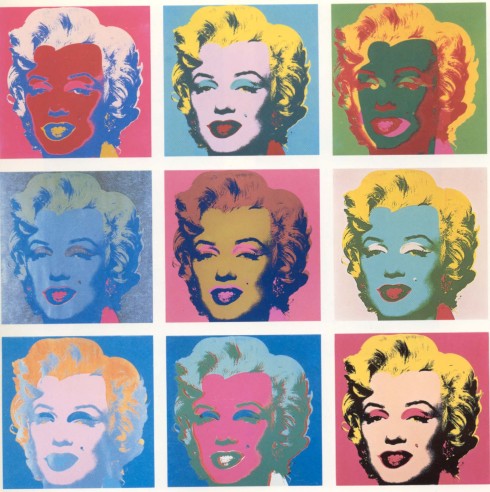Dark Shadows Poster and Warhol’s Marilyn 1960’s
Elizabeth Snead from the The Hollywood Reporter magazine, suggests that Burton’s posters are similar to Warhol’s portraits. One could argue that the complimentary colours, the textures and the stylised appearance of each particular character may feature a reference to the Pop Art Movement.
Klaus Honnef explains how Pop Art emphasised contemporary representations such as advertising, product design and comics, which gained a high level of interest from the public during the 1960’s – 70’s. Andy Warhol was one of the most influential artists from the movement who replicated celebrities and everyday, commercialised products.
It could be argued that Dr Hoffman’s bright, curly hair, her bright green eye shadow and her red lipstick feature similarities to Warhol’s Marilyn. Warhol’s portrait features vibrant complimentary colours, which emphasises the actress’s physical attributes such as her eyes and her lips.
In comparison to the artist’s screen prints, the dark shadows posters do feature additional elements or details, such as the sunglasses and the outfits. One could argue that the posters are an appropriation of Warhol’s art and the entire film, which is based in the 70’s may feature similar aesthetics to Pop Art.
On the other hand, Warhol’s Marilyn may document the absence of the celebrity whose presence only exists within advertising, photography and Popular culture, which is also emphasised by John David Ebert.
Ebert refers to Walter Benjamin who argues that “photography or film” displaces the original image or context. One could argue that nothing is original, almost every medium replicates or imitates a particular object or form. Even painting represents a particular subject through the artist’s perspective.
Is it possible to identify the death of Marilyn Monroe through Warhol’s screen prints? Can the viewer recognise the absence of the actress or can Popular Culture or contemporary art revitalise a particular image or representation?
Is it possible to acknowledge that a portrait is a representation of a skull? It’s strange to look into the mirror and recognise that there is only flesh and other internal organs separating the skull from the exterior. It’s interesting to recognise that I am actually looking at real human skulls on a daily basis.
Jacque Lynn Foltlyn also argues that recent or contemporary representations of the skull, reflects society’s awareness for their own existence. Perhaps the internal becomes externalized through advertising, photography, art and design.
D*Face Marilyn Monroe
Although there isn’t a lot of information in relation to this particular work, one could argue that this particular image demonstrates that Warhol’s portraits are continually reproduced through contemporary mediums or styles. Marilyn is combine with a representation of the skull, which may intensify the death of Ms Monroe. Although is the actual image or meaning indistinguishable through mass production?
Elizabeth Snead. “Johnny Depp’s ‘Dark Shadow’ Posters Recall Andy Warhol’s Pop Art Portraits.” The Hollywood Reporter, 2012 http://www.hollywoodreporter.com/fash-track/johnny-depp-dark-shadow-posters-302941. (Accessed 12/5/12)
Honneff, Klaus. Pop Art. Hohenzollering Taschen, 2004. p.6-10
Ebery, John. D. Dead Celebrities, Living Icons: Tradegy and Fame in the Age of the Multimedia Superstar. California ABC – CLIO, LLC, 2010.
Foltlyn, Jacque.L “To Die For: Skull Style and Corpse Chic in Fashion, Imagery and Branding.” Scan Journal 7 (2010).
Image Citations
The Hollywood Reporter, http://www.hollywoodreporter.com/fash-track/johnny-depp-dark-shadow-posters-302941
http://viuu.co.uk/blog/artist-twitter-backgrounds-pop-art/
http://paulbaines.co.uk/2009/02/dface-the-walls-of-conformity/



